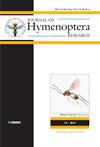Two new Hoplitis species of the subgenus Hoplitis Klug, 1807 (Hymenoptera, Megachilidae) and the nesting biology of H. astragali sp. nov. in Dagestan
IF 1.4
3区 农林科学
Q2 ENTOMOLOGY
引用次数: 0
Abstract
Hoplitis astragalisp. nov., a member of the H. monstrabilis species group, and H. dagestanicasp. nov., a member of the H. adunca species group, are described. The former species is known from Dagestan in Russia, Azerbaijan, and Turkmenistan, the latter only from Dagestan. Nests of H. astragali are described. Females of this species excavated burrows in a vertical clay cliff, but sometimes chose a horizontal surface for nest excavation, particularly at the entrance of old burrows of Xylocopa olivieri (Apidae). The nest burrows of H. astragali were either sub-vertical or sub-horizontal. The nests were composed of one to three brood cells, an empty vestibule in front of the outermost cell, and a closing plug at the nest entrance made of moistened mud. The inner surface of the cells was covered with a thin wall composed of compact soil, most probably built by the female bee after cell excavation. The pollen loaf was very liquid and had a spherical shape. The egg was deposited on its top. The cocoon consisted of a single thin layer, which uniformly covered the whole inner surface of the cell. There was one generation per year. The prepupae hibernated. Sapyga caucasica (Sapygidae) was recorded in the nests as a kleptoparasite. Both females and males of H. astragali exclusively visited flowers of two species of the genus Astragalus (Fabaceae).Hoplitis Klug亚属的两个新种,1807(膜翅目,Megachilidae)和H.Astralali sp.nov.在达吉斯坦的筑巢生物学
Hoplitis astragalisp。11月11日,H. monstrabilis物种组的成员,和H. dagestanicasp。十一月,一个成员的H. adunca种组,描述。前一种已知来自俄罗斯,阿塞拜疆和土库曼斯坦的达吉斯坦,后者仅来自达吉斯坦。描述了黄芪的巢。雌性在垂直的粘土悬崖上挖洞,但有时会选择水平的表面进行筑巢,特别是在木蝗的旧洞入口处。黄芪的巢穴呈亚垂直或亚水平分布。巢由一到三个育巢室组成,最外面的巢室前面有一个空的前厅,巢入口处有一个用湿泥做成的封闭塞。细胞的内表面覆盖着一层由致密土壤组成的薄壁,很可能是雌蜂挖掘细胞后建造的。花粉团呈液体状,呈球形。蛋被放在它的顶部。茧由一薄层组成,均匀地覆盖在细胞的整个内表面。每年只有一代。预蛹冬眠了。在巢中记录有白蚁(Sapyga caucasica)作为一种窃食寄生虫。黄芪雌蜂和雄蜂都专门拜访了黄芪属(豆科)的两种花。
本文章由计算机程序翻译,如有差异,请以英文原文为准。
求助全文
约1分钟内获得全文
求助全文
来源期刊
CiteScore
2.60
自引率
15.40%
发文量
68
审稿时长
>12 weeks
期刊介绍:
The Journal of Hymenoptera Research is a peer-reviewed, open-access, rapid online journal launched to accelerate research on all aspects of Hymenoptera, including biology, behavior, ecology, systematics, taxonomy, genetics, and morphology.
All published papers can be freely copied, downloaded, printed and distributed at no charge for the reader. Authors are thus encouraged to post the pdf files of published papers on their homepages or elsewhere to expedite distribution. There is no charge for color.

 求助内容:
求助内容: 应助结果提醒方式:
应助结果提醒方式:


